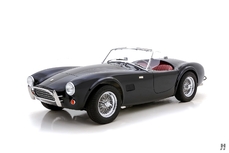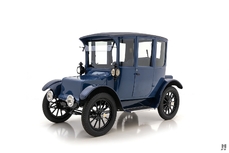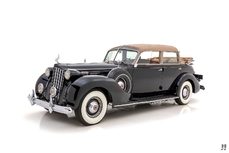Mack G-Model Truck 1933
General description :
As one of America’s most enduring heavy-duty truck manufacturers, Mack’s pioneering origins date to 1890 when John M. “Jack” Mack joined the Fallesen & Berry carriage and wagon works in Brooklyn, New York. By 1893, Jack and brother Augustus purchased the company and William, another brother, joined them the next year. Carriages soon gave way to wagons and experiments with steam and electric power, with the internal-combustion engine ultimately favored. “Old No. 1,” the first Mack sold, was initially configured as a passenger bus for Brooklyn’s Prospect Park that was built in 1900 and later converted into a truck. Soon, Mack firmly established itself as America’s premier manufacturer of powerful heavy-duty trucks using traditional, yet well-proven engineering principles and tough mechanical components. A series of shrewd mergers and acquisitions through Mack’s earlier years gave the company the ability to produce engines, transmissions and other necessary mechanical components in Allentown, Pennsylvania and at its New Brunswick and Plainfield plants located in New Jersey.
One of Mack’s most successful business lines was the company’s Fire Apparatus Division, active from 1911 to 1984 and headquartered in Allentown, Pennsylvania for much of its existence, punctuated by a decade from 1941 to 1951 in Long Island City, New York. Beginning with firefighting tools and equipment, Mack’s Fire Apparatus Division progressed to production of complete fire trucks beginning with the Mack AB in 1914, progressing to the AP and B-Series chassis, both very long-running and versatile designs. Development was methodical and progressed through a veritable myriad of models, sub-models, and improved specifications throughout the long history of Mack’s Fire Apparatus Division, assuring buyers a Mack-built fire truck virtually tailor-made to meet their individual requirements.
The highly engaging 1931 Mack fire engine offered here is based on Mack’s BG-Series chassis, introduced in 1929 and built through 1937, with 2,904 total examples of such chassis produced. Combining the prior BB-Series chassis specification of 1928-1932, which answered the call for higher load capacity and higher-speed performance, Mack’s long-running BG was primarily distinguished by its more-powerful engine. Accompanied by production records supplied by the Mack Trucks Historical Museum in Allentown Pennsylvania, this fascinating and attractive 1931 Mack Type 50 BG fire engine was dispatched from the Allentown, Pennsylvania factory on January 2, 1931, and delivered via Mack’s Long Island City Branch to the Floral Park, Long Island Village Fire Department on February 12, 1931. A period photograph depicts this specific fire engine as delivered, with Floral Park F.D. livery and Engine No. 3 designation. Based on the 156-inch type BG chassis, this Mack Type 50 fire engine is an original and highly versatile “Triple Combination” unit, comprising a water tank, pump, and hoses. Copies of detailed build records accompanying the Mack list all original equipment, parts numbers, and mechanical specifications. Subsequently, the highly equipped Mack was operated by the Salida, Colorado Volunteer Fire Department and it retains this eye-catching red-and gold leaf livery today.
This wonderful piece of industrial and fire-service history features a light and pleasing patina overall. The red paint finish and gold-leaf accents remain very attractive, as does the exterior brightwork, while the instrument panel should certainly benefit from detailing and polishing. Some minor flaws and areas of cracking are noted in the paintwork, however, these imperfections do not detract from this truck’s wonderful presence.
The sophisticated BG-specification inline 6-cylinder engine retains correct, original-appearing finishes that are mostly intact, featuring magneto-type ignition with twin spark plugs per cylinder. Power delivery is via a 4-speed transmission and spiral bevel-type rear differential. The Mack features a wide array of vintage fire apparatus including Mack-scripted portable fire extinguishers, a huge Appleton spotlight, Brass locomotive bell, hooked ladders, solid and flexible fire hoses, hose nozzles, and so much more. Period style Goodyear tires on hub-pilot wheels provide road contact. Added turn-signal indicators enhance safety on parades or occasional drives. Documented by copies of original Mack chassis records, highly equipped, and looking virtually ready for action, this 1931 Mack Type 50 Triple Combination fire engine is a rarely seen early Mack fire engine, ideal for marque collectors and fire apparatus enthusiasts alike and more than worthy of its iconic “Bulldog” radiator mascot.
*Please note, this Mack is titled as a 1933
Offers welcome and trades considered
1933 Mack G-Model Truck is listed for sale on ClassicDigest in St. Louis by Hyman Ltd. for $49500.
Car Facts
Car type : Car Make : Mack Model : G-Model Model Version : Truck Engine size : 0.0 Model Year : 1933 Sub type : Truck Location : Missouri Vehicle Registration : Undefined
49500 $
Other cars listed for sale by this dealer
About Mack
Mack Trucks, recognized for their durability, robustness, and iconic bulldog hood ornament, hold a significant place in American trucking history. Here's an overview of their history and some notable models:History:
Early Origins: Founded in 1900 by brothers Jack and Augustus Mack, Mack Trucks initially operated as the Mack Brothers Company, specializing in the manufacturing of buses. Later, in 1905, they ventured into building heavy-duty trucks.
Innovations: Mack Trucks became known for innovations such as the chain-driven rear axles and the introduction of the first cab-over-engine (COE) trucks in 1905, enhancing maneuverability and load capacity.
Iconic Models:
Mack AC Series: Introduced in the 1910s, the AC models became a backbone of World War I logistics, gaining recognition for their reliability.
Mack Bulldog Series: These models, particularly in the 1930s and 1940s, cemented Mack's legacy in American trucking. The Mack Bulldog, symbolizing their ruggedness, became an emblematic feature of their trucks.
Mack R Series: The R Model, introduced in the 1960s, marked a shift in truck design with its distinctive appearance and was well-regarded for its sturdiness.
Mack Super-Liner: Introduced in the late 1970s, the Super-Liner was a powerful long-haul truck designed for heavy-duty applications.
Mack Granite: Launched in the 1980s, the Granite series catered to construction and heavy transportation needs, recognized for its robustness and versatility.
Contributions and Legacy:
Military Contribution: Mack Trucks played a significant role in supplying military vehicles during World War I and World War II, earning praise for their reliability and sturdiness.
Cultural Impact: The bulldog hood ornament became an iconic symbol associated with the Mack Trucks, symbolizing their strength and durability.
Continued Presence: Mack Trucks continues to be a prominent name in the commercial trucking industry, offering a range of models for various applications, including long-haul, construction, and vocational purposes.
Modern Innovations: Mack Trucks have continued to evolve, integrating advanced technologies for increased fuel efficiency, safety features, and driver comfort in their newer models.
Mack Trucks have remained a symbol of American craftsmanship, reliability, and durability in the commercial trucking industry, leaving an enduring impact on transportation history in the United States.




















